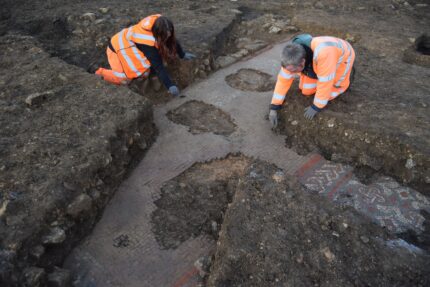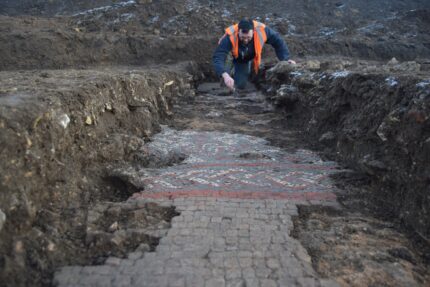 An archaeological survey of the site of a future Aldi supermarket in Olney, Buckinghamshire, has uncovered a Roman polychrome mosaic. The mosaic consists of geometric designs made with tesserae in four colors: dark grey, red, dark blue and white. One thick border contains the two-strand woven guilloche pattern. The larger decorative panel contains Solomon knots, stylized palmette patterns that look like stretched out hearts and diamond shapes.
An archaeological survey of the site of a future Aldi supermarket in Olney, Buckinghamshire, has uncovered a Roman polychrome mosaic. The mosaic consists of geometric designs made with tesserae in four colors: dark grey, red, dark blue and white. One thick border contains the two-strand woven guilloche pattern. The larger decorative panel contains Solomon knots, stylized palmette patterns that look like stretched out hearts and diamond shapes.
The mosaic paves the floor of a large room in a Roman building. Most of the mosaic that has been recovered thus far was from the edge of the room. The remains of two smaller rooms were found next to it. Mosaics were expensive decorations usually reserved for the homes of the wealthy or public buildings. It is not clear which function this structure had. Several other stone structures found at the site were identified as a bath house or water collection cisterns.
The design style is consistent with the work of the Durobrivan group from the East Midlands and as such likely date to the third quarter of the 4th century. This school of mosaic art is named after Durobrivae, a Roman town in what is now Water Newton, Cambridgeshire. Durobrivae was a civilian settlement attached to a 1st century A.D. Roman fort that is about 50 miles north of Olney. It was a center of production for a distinctive light-on-dark pottery type known as Nene Valley Colour Coated Ware, and one of the 10 or so identified school of mosaic design in Roman Britain.
 The excavation was triggered by the location of the planned Aldi which is near the Roman site at Olney, the remains of an ancient settlement dating to between the 2nd and 4th centuries A.D. Archaeologists expected, therefore, to make some Roman finds, but were thinking more along the lines of burials rather than a luxury mosaic installation.
The excavation was triggered by the location of the planned Aldi which is near the Roman site at Olney, the remains of an ancient settlement dating to between the 2nd and 4th centuries A.D. Archaeologists expected, therefore, to make some Roman finds, but were thinking more along the lines of burials rather than a luxury mosaic installation.
Much of the mosaic pavement extends under a city street, so unfortunately it will not be fully excavated. Nor will it be removed. The mosaic will remain in situ, covered for its protection. Archaeologists and cultural authorities have proposed a plan to keep it safe while construction continues.